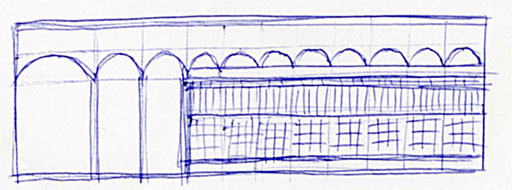3.1.3 Symmetry
Symmetry is all around us. You only have to look at your own body to see that your right half is a mirror image of your left half – well approximately. This is an example of mirror symmetry with an imaginary mirror line running vertically through your head and body. Nature is a good source of examples of symmetry.
There are fewer examples of horizontal symmetry, some being a tin can, a scarf and the cross-section of a roof-supporting beam. Can you think of any others?
Symmetry is a variation of repetition and is exploited in a wide range of products. But just like the human body there can be subtle but important differences between the two halves of a product. Take a car for example. It is broadly symmetrical but, of course, it only has one steering wheel and one set of controls. What about your mobile phone? Some parts of the composition may be symmetrical while other parts are not.
Activity 12 Phone symmetry
Take your mobile phone or any other phone you have access to. Look at it carefully and make a simple drawing to show where it is symmetrical and where it is not.
Discussion

In overall structure this mobile phone (Figure 11) is symmetrical about a vertical centreline. It is not horizontally symmetrical because the screen shows the date and time on one end and a slide bar to access the menu on the other.
A lot of architecture is designed with symmetry in mind. This provides a sense of order, stability, permanence and safety, all of which are important in our perceptions of what successful buildings should intrinsically represent. For example, look at the city gate in Figure 12.

Symmetrical design, where the two sides mirror each other, can be seen in many examples of consumer products. This is because consumers often favour objects that are symmetrical. For example, course author Nicole Schadewitz made this observation:
When I purchased my mobile phone I think its symmetry did influence my decision to buy. Somehow the balanced layout of the elements on the screen seems calming, safe and reassuring. My sofa also has a symmetrical design; somehow it expresses stability and comfort to me.
Not all balanced compositions are symmetrical. Asymmetrical design is frequently seen around us but is often more complex and it is more difficult to achieve a balanced whole. For example, look at the T-shirt designs shown in Figure 13. Asymmetrical designs might use varying proportions and textures of elements to achieve their balance.
In the first T-shirt the Ace symbol and the word Ace are aligned on a vertical axis, so the composition is balanced. In the second design, a smaller ace symbol and word are positioned in the upper left corner. In order to balance the design, a scaled ace symbol is placed diagonally opposite.
Look again at the picture of Chandigarh High Court (Figure 14a), and note how this is an example of asymmetrical architecture.

Figure 14b is a sketch that helps to demonstrate this.


